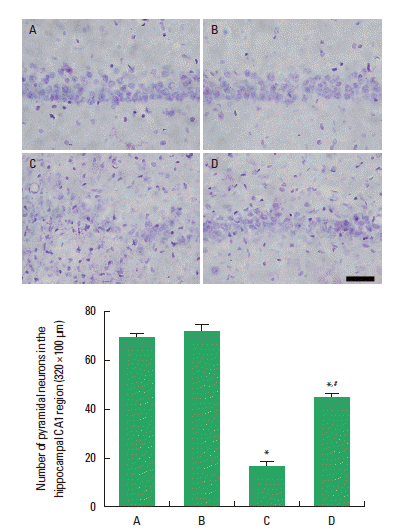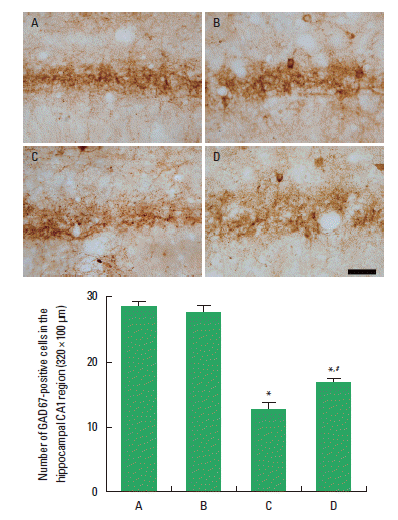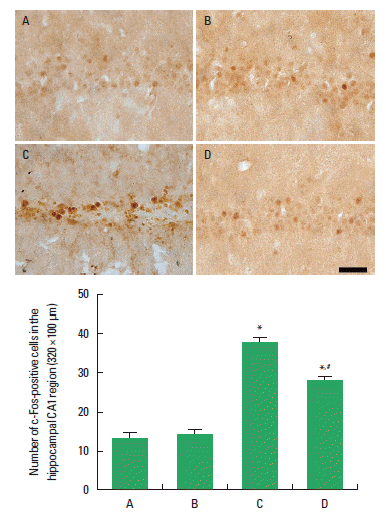INTRODUCTION
Epilepsy is a common neurological disorder characterized by seizure and loss of neuronal cells by abnormal rhythmic firing of neurons in the brain (Duncan et al., 2006). Gamma-aminobutyric acid (GABA) is implicated in the suppression on initiation and spreading of seizure (Coulter et al., 2001). Glutamic acid decarboxylase (GAD) is the rate limiting enzyme for the production of GABA, and GAD is also used as a marker for GABAergic neurons. GAD exists as two major isoforms, GAD65 and GAD67. Of these, GAD67 is a key enzyme for GABA synthesis, and GAD67 is constitutively active and produces GABA in the central nervous system (Kanaani et al., 2010).
c-Fos is an immediate early gene, and its expression is sometimes used as a marker for stimuli-induced changes in the neurons (Zhang et al., 1999). Expression of c-Fos is extensively used as a marker for neuronal activation (De Oliveira et al., 2001). Pilocarpine induces seizures and also elicits c-Fos expression (Barone et al., 1993). The correlation between c-Fos-induced neuronal activation and severity of neurodegeneration was reported following pilocarpine-induced seizure (Dubé et al., 1998; Motte et al., 1998).
Neurotrophins play an important role as the underlying mechanism of synaptic plasticity. Epileptic seizure activity induces transient change of neurotrophins expression in neurons (Lähteinen et al., 2004). In particular, brain-derived neurotrophic factor (BDNF) is a neurotrophin implicated in neuronal survival and plasticity after binding to high-affinity receptor, tyrosine kinase receptor B (TrkB). Elevated BDNF-trkB signaling with the memory decline caused by neurodegenerative diseases reflects a compensatory neuroplastic response to neuronal injury associated with neurodegenerative processes (Wang et al., 2009).
Exercise is known to reduce seizure frequency and severity through raising seizure threshold in epilepsy patients (Nakken, 1999). Arida et al. (1999) reported that aerobic physical program reduced the frequency of spontaneous recurrent seizure in the pilocarpine-induced epilepsy rats. Alleviating effect of exercise on seizure activity was also reported (Kim et al., 2013; Rambo et al., 2009), however, the effect of exercise on GABAergic neuronal loss in epilepsy was not documented. In the present study, we investigated the effect of treadmill exercise on GABAergic neuronal loss in relation with neuronal activation using pilocarpine-induced epileptic rats.
MATERIALS AND METHODS
Experimental animals
Adult male rats (250±10 g) were used in this experiment. The experimental procedures were performed in accordance with the animal care guidelines of the National Institutes of Health (NIH) and the Korean Academy of Medical Sciences. The rats were housed under controlled temperature (20±2°C) and lighting (07:00 to 19:00) conditions with food and water available ad libitum. The rats were randomly divided into four groups (n=10 in each group): control group, control and treadmill exercise group, pilocarpine-induced epilepsy group, and pilocarpine-induced epilepsy and treadmill exercise group.
Pilocarpine-induced epilepsy model
Epilepsy was induced by intraperitoneal injection of 320 mg/kg pilocarpine hydrochloride (Sigma Chemical Co., St. Louis, MO, USA), according to the previously described method (Blanco et al., 2008). Scopolamine methyl nitrate (Sigma Chemical Co.) was given 30 min prior to pilocarpine injection in order to minimize peripheral autonomic effect. The rats showing stage 4 or 5 convulsive seizure were included in the pilocarpine-induced epilepsy groups, as the described previously described method (Racine, 1972). Seizure was allowed to last for 60 min and then it was terminated by intraperitoneal injection of diazepam (10 mg/kg, Samjin, Seoul, Korea).
Treadmill exercise protocol
The rats in the exercise groups were forced to run on a motorized treadmill for 30 min once a day for 2 weeks, according to the previously described method (Heo et al., 2014). The treadmill exercise load consisted of running at 2 meters/min for the first of 5 min, at 3 meters/min for the next 5 min, and then at 5 meters/min for the last 20 min at 0 degree of inclination. The rats in the non-exercise groups were left in treadmill without running for the same period as the exercise group.
Tissue preparation
The rats were sacrificed immediately after performing last exercise. The animals were anesthetized using Zoletil 50® (10 mg/kg, i.p.; Vibac Laboratories, Carros, France). Then, they were transcardially perfused with 50 mM phosphate-buffered saline (PBS) and fixed with 4% paraformaldehyde in 100 mM phosphate buffer (PB, pH 7.4). The brains were dissected, and post fixed in the same fixative overnight and transferred into a 30% sucrose solution for cryoprotection. Sagittal sections of 40 μm thick were made using a freezing microtome (Leica, Nussloch, Germany).
Nissl staining
For evaluation of histological damage, brain slices were stained with 0.1% cresyl violet (Sigma Chemical Co.), according to the previously described method (Yoon et al., 2013). Pyramidal neurons were defined when a clear nucleus were found. The sections were dehydrated by immersing for 2 h in 50%, 70%, 80%, 90%, 95%, and 100% ethanol baths in succession at room temperature. After dehydration, the sections were mounted using Permount® (Fisher Scientific, Fairlawn, NJ, USA).
GAD67 immunohistochemistry
For the visualization of the GABAergic neurons, GAD67 immunohistochemistry was performed, according to the previously described method (Tochitani and Kondo, 2013). The sections were incubated overnight with mouse anti-GAD67 antibody (1:500; Santa Cruz Biotechnology, Santa Cruz, CA, USA), and then they were incubated for another 2 h with the mouse biotinylated secondary antibody (1:200; Vector Laboratories, Burlingame, CA, USA). The bound secondary antibody was then amplified using a Vector Elite ABC kit® (1:200, Vector Laboratories). The antibody-biotin-avidin-peroxidase complex was visualized using 0.02% 3, 3′-diaminobenzidine (DAB). The sections were finally mounted onto gelatin-coated slides. The slides were air-dried overnight at room temperature, and the coverslips were mounted using Permount® (Fisher Scientific).
c-Fos immunohistochemistry
For the visualization of the neuronal activity, c-Fos immunohistochemistry was performed, according to the previously described method (Park et al., 2013). The sections were incubated overnight with mouse anti-c-Fos antibody (1:500; Santa Cruz Biotechnology), and then they were incubated for another 2 h with the rabbit biotinylated secondary antibody (1:200; Vector Laboratories). The bound secondary antibody was then amplified using a Vector Elite ABC kit® (1:200, Vector Laboratories). The antibody-biotin-avidin-peroxidase complex was visualized using 0.02% DAB. The sections were finally mounted onto gelatin-coated slides. The slides were air-dried overnight at room temperature, and the coverslips were mounted using Permount® (Fisher Scientific).
Western blot analysis for BDNF and TrkB
Western blotting for BDNF and TrkB expressions was performed, according to the previously described method (Kim et al., 2014). The hippocampal tissues were collected, and then were immediately frozen at −70°C. The hippocampal tissues were homogenized on ice, and lysed in a lysis buffer containing 50 mM HEPES (pH 7.5), 150 mM NaCl, 10% glycerol, 1% Triton X-100, 1 mM PMSF, 1 mM EGTA, 1.5 mM MgCl2 6H2O, 1 mM sodium orthovanadate, and 100 mM sodium flouride. Protein content was measured using a Bio-Rad colorimetric protein assay kit (Bio-Rad, Hercules, CA, USA). Protein (30 μg) was separated on SDS-polyacrylamide gels and transferred onto a nitro-cellulose membrane. Mouse actin antibody (1:1,000; Santa Cruz Biotechnology), rabbit BDNF antibody (1:1,000; Santa Cruz Biotechnology) and rabbit TrkB antibody (1:1,000; Santa Cruz Biotechology) were used as the primary antibodies. Horseradish peroxidase-conjugated anti-rabbit antibody for BDNF (1:2,000; Vector Laboratories) and TrkB (1:3,000; Vector Laboratories) were used as the secondary antibodies. Band detection was performed using as enhanced chemiluminescence (ECL) detection system (Amersham Pharmacia Biotech GmbH, Freiburg, Germany).
Statistical analysis
To compare the relative expressions of BDNF and TrkB, the detected bands were calculated densitometrically using Image-Pro® Plus software (Media Cybernetics Inc., Silver Spring, MD, USA). The numbers of pyramidal neurons, c-Fos-positive and GAD-67-positive cells in the hippocampal CA1 region (320 ×100 μm) were counted hemilaterally. All data were analyzed using SPSS 21.0 statistical software (SPSS Inc., Chicago, IL, USA). The data were expressed as the mean±standard error of the mean (SEM). For the comparison among the groups, one-way ANOVA and Duncan’s post-hoc test were performed with P<0.05 as an indication of statistical significance.
RESULTS
Effect of treadmill exercise on the number of pyramidal neurons in the hippocampal CA1 region
Photomicrographs of neuronal loss in the hippocampal CA1 region are presented in Fig. 1. The number of pyramidal neurons was 71.35±3.00 in the control group, 73.00±2.48 in the control and treadmill exercise group, 16.80±3.58 in the pilocarpine-induced epilepsy group, and 40.75±4.92 in the pilocarpine-induced epilepsy and treadmill exercise group. Injection of pilocarpine decreased the number of pyramidal neurons in the hippocampal CA1 region (P<0.05). Treadmill exercise alleviated pilocarpine-induced neuronal loss in the hippocampal CA1 region (P<0.05). However, in the normal rats, treadmill exercise exerted no significant effect on the number of pyramidal neurons in the hippocampal CA1 region.
Effect of treadmill exercise on the number of GAD67-positive cells in the hippocampal CA1 region
Photomicrographs of GAD67-positive cells in the hippocampal CA1 region are presented in Fig. 2. The number of GAD67-positive cells was 28.10±0.53 in the control group, 27.57±0.37 in the control and treadmill exercise group, 12.31±0.36 in the pilocarpine-induced epilepsy group, and 19.14±0.37 in the pilocarpine-induced epilepsy and treadmill exercise group. Injection of pilocarpine decreased the number of GAD67-positive cells in the hippocampal CA1 region (P<0.05). Treadmill exercise alleviated pilocarpine-induced GABAergic neuronal loss in the hippocampal CA1 region (P<0.05). However, in the normal rats, treadmill exercise exerted no significant effect on the number of GAD67-positive cells in the hippocampal CA1 region.
Effect of treadmill exercise on the number of c-Fos-positive cells in the hippocampal CA1 region
Photomicrographs of c-Fos-positive cells in the hippocampal CA1 region are presented in Fig. 3. The number of c-Fos-positive cells was 14.14±2.32 in the control group, 14.47±1.76 in the control and treadmill exercise group, 37.47±3.07 in the pilocarpine-induced epilepsy group, and 25.90±2.53 in the pilocarpine-induced epilepsy and treadmill exercise group. Injection of pilocarpine increased the number of c-Fos-positive cells in the hippocampal CA1 region (P<0.05). Treadmill exercise alleviated pilocarpine-induced c-Fos expression in the hippocampal CA1 region (P<0.05). However, in the normal rats, treadmill exercise exerted no significant effect on the number of c-Fos-positive cells in the hippocampal CA1 region.
Effect of treadmill exercise on the expressions of BDNF and trkB in the hippocampus
We determined the relative expression of BDNF in the hippocampus (Fig. 4). When the level of BDNF (26 kDa) in the control group was set at 1.00, the level of BDNF was 1.20±0.04 in the control and treadmill exercise group, 1.44±0.13 in the pilocarpine-induced epilepsy group, and 1.12±0.02 in the pilocarpine-induced epilepsy and treadmill exercise group. Injection of pilocarpine increased the expression of BDNF in the hippocampus (P<0.05). Treadmill exercise suppressed pilocarpine-induced BDNF expression (P<0.05). In the normal rats, treadmill exercise exerted no significant effect on the BDNF expression in the hippocampus.
When the level of trkB (95–145 kDa) in the control group was set at 1.00, the level of trkB was 1.17±0.03 in the control and treadmill exercise group, 2.08±0.21 in the pilocarpine-induced epilepsy group, and 1.35±0.05 in the pilocarpine-induced epilepsy and treadmill exercise group. Injection of pilocarpine n increased the expression of trkB in the hippocampus (P<0.05). Treadmill exercise suppressed pilocarpine-induced trkB expression (P<0.05). In the normal rats, treadmill exercise exerted no significant effect on the trkB expression in the hippocampus
DISCUSSION
Pilocarpine-induced seizure initiates early cell damage in the hippocampus (Curia et al., 2008). Neuronal loss is one of the most important phenomena in the brain following epileptic insult (Pitkanen and Sutula, 2002). Liu et al. (2006) reported that pilocarpine-induced seizure showed increment in neuronal loss and decrement in total number of neurons in the hippocampal CA1 region. Reduced neurons in the hippocampal CA1 region are associated with memory deficit and cognitive impairment (Ma et al., 2008). In the present study, neuronal loss in the hippocampal CA1 region was observed after pilocarpine-induced seizure. In contrast, treadmill exercise inhibited hippocampal neuronal loss in the epileptic rats.
Loss of GAD after epileptic seizure was found in the hippocampal dentate gyrus (Obenaus et al., 1993) and hippocampal CA1 region (Houser and Esclapez, 1996). Imbalance between GABAergic system and the blockade of glutamate receptor might lead to neuronal degeneration in the brain of gerbils (Kwak et al., 2005). Moreover, reduced number of GABAergic neurons in the hippocampus was found in the epileptic mice (Danzer et al., 2010). In the present study, we found that GAD expression in the hippocampal CA1 region was reduced by pilocarpine-induced seizure. In contrast, treadmill exercise increased GAD67 expression in the epileptic rats. These results revealed that treadmill exercise prevented GABAergic neuronal loss caused by epileptic seizure.
c-Fos is a reliable marker of neuronal activation that undergoes a rapid and transient increase following a variety of external stimuli, such as epileptic seizure, ischemia, and stress (Hughes and Dragunow, 1995; Silveira et al., 2002). Enhanced c-Fos expression correlates closely with the propagation of cell death after pilocarpine-induced seizure (Preston et al., 1996; Smeyne et al., 1993). Our data also showed that c-Fos expression in the hippocampal CA1 region was increased in response to epileptic seizure. In contrast, treadmill exercise inhibited c-Fos expression in the epileptic rats. These results showed that treadmill exercise suppressed epilepsy-induced neuronal activation.
BDNF is found in hippocampus which is highly sensitive for epileptic insult (Wang et al., 2009). Seizure increases expressions of BDNF and TrkB in the mossy fiber pathway of hippocampus (Li et al., 2003). Increased endogenous BDNF expression after a brain insult may be an important mediator of the cellular events that lead to the development of spontaneous seizures or epileptogenesis (Scharfman, 2005). In the present study, epileptic seizure increased BDNF and TrkB expressions in the hippocampus. In contrast, treadmill exercise suppressed BDNF and TrkB expressions in the epileptic rats. These results suggest that treadmill exercise counteracted to the compensatory adapted response of epileptic seizure.
In the present study, treadmill exercise prevented GABAergic neuronal loss and inhibited neuronal activation in the hippocampal CA1 region through the down-regulation of BDNF-TrkB signaling pathway. These findings offer a possibility that treadmill exercise may provide preventive or therapeutic value for the epilepsy.












